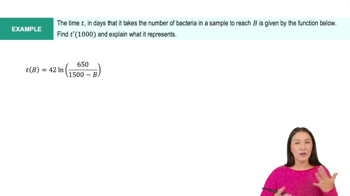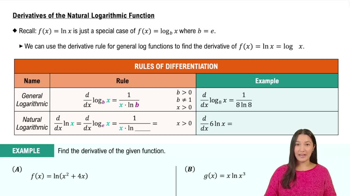Table of contents
- 0. Functions7h 52m
- Introduction to Functions16m
- Piecewise Functions10m
- Properties of Functions9m
- Common Functions1h 8m
- Transformations5m
- Combining Functions27m
- Exponent rules32m
- Exponential Functions28m
- Logarithmic Functions24m
- Properties of Logarithms34m
- Exponential & Logarithmic Equations35m
- Introduction to Trigonometric Functions38m
- Graphs of Trigonometric Functions44m
- Trigonometric Identities47m
- Inverse Trigonometric Functions48m
- 1. Limits and Continuity2h 2m
- 2. Intro to Derivatives1h 33m
- 3. Techniques of Differentiation3h 18m
- 4. Applications of Derivatives2h 38m
- 5. Graphical Applications of Derivatives6h 2m
- 6. Derivatives of Inverse, Exponential, & Logarithmic Functions2h 37m
- 7. Antiderivatives & Indefinite Integrals1h 26m
- 8. Definite Integrals4h 44m
- 9. Graphical Applications of Integrals2h 27m
- 10. Physics Applications of Integrals 2h 22m
6. Derivatives of Inverse, Exponential, & Logarithmic Functions
Derivatives of Exponential & Logarithmic Functions
Problem 3.9.97c
Textbook Question
97–100. Logistic growth Scientists often use the logistic growth function P(t) = P₀K / P₀+(K−P₀)e^−r₀t to model population growth, where P₀ is the initial population at time t=0, K is the carrying capacity, and r₀ is the base growth rate. The carrying capacity is a theoretical upper bound on the total population that the surrounding environment can support. The figure shows the sigmoid (S-shaped) curve associated with a typical logistic model. <IMAGE>
{Use of Tech} Gone fishing When a reservoir is created by a new dam, 50 fish are introduced into the reservoir, which has an estimated carrying capacity of 8000 fish. A logistic model of the fish population is P(t) = 400,000 / 50+7950e^−0.5t, where t is measured in years.
c. How fast (in fish per year) is the population growing at t=0? At t=5?
 Verified step by step guidance
Verified step by step guidance1
Identify the logistic growth function given in the problem: P(t) = \frac{400,000}{50 + 7950e^{-0.5t}}.
To find the rate of change of the population, calculate the derivative of P(t) with respect to t, denoted as P'(t). This derivative will give the rate of growth of the population at any time t.
Apply the quotient rule to differentiate the function P(t). The quotient rule states that if you have a function \frac{f(t)}{g(t)}, its derivative is \frac{f'(t)g(t) - f(t)g'(t)}{(g(t))^2}. Here, f(t) = 400,000 and g(t) = 50 + 7950e^{-0.5t}.
Calculate f'(t) and g'(t). Since f(t) = 400,000 is a constant, f'(t) = 0. For g(t), use the chain rule to find g'(t). The derivative of 7950e^{-0.5t} is -3975e^{-0.5t}.
Substitute f'(t), f(t), g(t), and g'(t) into the quotient rule formula to find P'(t). Evaluate P'(t) at t = 0 and t = 5 to find the rate of population growth at these times.
 Verified video answer for a similar problem:
Verified video answer for a similar problem:This video solution was recommended by our tutors as helpful for the problem above
Video duration:
7mPlay a video:
Was this helpful?
Key Concepts
Here are the essential concepts you must grasp in order to answer the question correctly.
Logistic Growth Function
The logistic growth function models population growth that is initially exponential but slows as the population approaches a maximum limit, known as the carrying capacity (K). The function is represented as P(t) = P₀K / (P₀ + (K - P₀)e^(-r₀t)), where P₀ is the initial population, r₀ is the growth rate, and t is time. This model is crucial for understanding how populations grow in environments with limited resources.
Recommended video:

Derivative of the Natural Logarithmic Function Example 7
Carrying Capacity
Carrying capacity (K) refers to the maximum population size that an environment can sustain indefinitely without degrading the habitat. It is a critical concept in ecology and population dynamics, as it influences the growth rate and stability of populations. In the context of the logistic model, as the population approaches K, the growth rate decreases, leading to a leveling off of the population size.
Recommended video:

Intro to the Chain Rule Example 2
Rate of Change
The rate of change in a population, often represented as dP/dt, indicates how quickly the population is increasing or decreasing at a given time. In the logistic growth model, this rate can be calculated by differentiating the logistic function with respect to time. Understanding the rate of change at specific time points, such as t=0 and t=5, is essential for predicting population dynamics and making informed management decisions.
Recommended video:

Intro To Related Rates

 4:50m
4:50mWatch next
Master Derivatives of General Exponential Functions with a bite sized video explanation from Callie
Start learningRelated Videos
Related Practice













